Trends in Sales and Industry Perspectives of Package Sizes of Carbonates and Confectionery Products
Abstract
:1. Introduction
2. Methods
2.1. Sales Trends According to Package Size: Carbonates and Confectionery
2.2. Food Industry Perspectives on Package Size: Carbonates and Confectionery
3. Results
3.1. Sales Trends According to Package Size: Carbonates (Retail and Foodservice)
3.2. Sales Trends According to Package Size: Confectionery (Retail Only)
3.3. Food Industry Perspectives on Package Size: Carbonates and Confectionery
3.3.1. Carbonates
3.3.2. Confectionery
4. Discussion
5. Conclusions
Supplementary Materials
Author Contributions
Funding
Institutional Review Board Statement
Informed Consent Statement
Data Availability Statement
Acknowledgments
Conflicts of Interest
References
- Zheng, M.; Rangan, A.; Meertens, B.; Wu, J.H.Y. Changes in Typical Portion Sizes of Commonly Consumed Discretionary Foods among Australian Adults from 1995 to 2011–2012. Nutrients 2017, 9, 577. [Google Scholar] [CrossRef] [PubMed] [Green Version]
- Smiciklas-Wright, H.; Mickle, S.J.; Goldman, J.D.; Cook, A. Foods commonly eaten in the United States, 1989–1991 and 1994–1996: Are portion sizes changing? J. Am. Diet. Assoc. 2003, 103, 41–47. [Google Scholar] [CrossRef] [PubMed]
- Hollands, G.J.; Marteau, T.M.; Jebb, S.A.; Lewis, H.B.; Wei, Y.; Higgins, J.P.T.; Ogilvie, D. Portion, package or tableware size for changing selection and consumption of food, alcohol and tobacco. Cochrane Database Syst. Rev. 2015. [Google Scholar] [CrossRef] [PubMed] [Green Version]
- Zlatevska, N.; Holden, S.S. Sizing up the effect of portion size on consumption: A meta-analytic review. J. Mark. 2014, 78, 140–154. [Google Scholar] [CrossRef]
- Steenhuis, I.P.M. Portion Size: Latest Developments and Interventions. Curr. Obes. Rep. 2017, 6, 10–17. [Google Scholar] [CrossRef] [PubMed] [Green Version]
- World Health Organization; Food and Agriculture Organization. Diet, Nutrition and the Prevention of Chronic Diseases; WHO Technical Report Series 916; WHO: Geneva, Switzerland, 2003. [Google Scholar]
- Sui, Z.W.W.; Louie, J.C.; Rangan, A. Discretionary food and beverage consumption and its association with demographic characteristics, weight status, and fruit and vegetable intakes in Australian adults. Public Health Nutr. 2017, 20, 274–281. [Google Scholar] [CrossRef] [PubMed] [Green Version]
- Australian Bureau of Statistics. Australian Health Survey: Nutrition First Results—Food and Nutrients, 2011–2012. Available online: https://www.ausstats.abs.gov.au/Ausstats/subscriber.nsf/0/4683FD7315DFDFDBCA257D080014F9E0/$File/australian%20health%20survey%20nutrition%20first%20results%20-%20food%20and%20nutrients,%202011-12.pdf (accessed on 11 March 2020).
- Wartella, E.A.; Boon, C.S. Front-of-Package Nutrition Rating Systems and Symbols: Phase I Report; National Academies Press: Cambridge, MA, USA, 2010. [Google Scholar]
- Roberts, C.; Maplethorpe, N.; Cox, L.; Meadows, S.; Nicholson, S.; Page, P.; Swan, G. National Diet and Nutrition Survey: Results from Years 7 and 8 (Combined) of the Rolling Programme (2014/2015 to 2015/2016); Public Health England: London, UK, 2018. [Google Scholar]
- Jones, A.C.; Hammond, D. Beverage consumption and energy intake among Canadians: Analyses of 2004 and 2015 national dietary intake data. Nutr. J. 2019, 18, 60. [Google Scholar] [CrossRef] [PubMed] [Green Version]
- Lewis, M.L.A. Effective Portion Size Strategies. An evidence Review Prepared for the Australian Department of Health on Behalf of the Australian Prevention Partnership Centre; The Australian Prevention Partnership Centre: Sydney, NSW, Australia, 2017. [Google Scholar]
- Crino, M.; Sacks, G.; Wu, J.H.Y. A Review of Population-Level Actions Targeting Reductions in Food Portion Sizes to Address Obesity and Related Non-communicable Diseases. Curr. Nutr. Rep. 2016, 5, 323–332. [Google Scholar] [CrossRef]
- Almiron-Roig, E.; Hollands, G.J.; Vargas, M.Á.; Brunstrom, J.M. A review of evidence supporting current strategies, challenges, and opportunities to reduce portion sizes. Nutr. Rev. 2019, 78, 91–114. [Google Scholar] [CrossRef] [PubMed]
- Mattes, R.D. Evidence on the “normalizing” effect of reducing food-portion sizes. Am. J. Clin. Nutr. 2018, 107, 501–503. [Google Scholar] [CrossRef] [PubMed] [Green Version]
- Robinson, E.K.I. Portion size and later food intake: Evidence on the “normalizing” effect of reducing food portion sizes. Am. J. Clin. Nutr. 2018, 107, 640–646. [Google Scholar] [CrossRef] [PubMed]
- Robinson, E.H.J.; Keenan, G.S.; Kersbergen, I. When a portion becomes a norm: Exposure to a smaller vs. larger portion of food affects later food intake. Food Qual. Prefer. 2019, 75, 113–117. [Google Scholar] [CrossRef] [PubMed]
- Passport Global Market Information Database; Euromonitor International: London, UK, 2019.
- Tricco, A.C.; Lillie, E.; Zarin, W.; O’Brien, K.K.; Colquhoun, H.; Levac, D.; Moher, D.; Peters, M.D.J.; Horsley, T.; Weeks, L.; et al. PRISMA Extension for Scoping Reviews (PRISMAScR): Checklist and Explanation. Ann. Intern. Med 2018, 169, 467–473. [Google Scholar] [CrossRef] [PubMed] [Green Version]
- IBISWorld AU: Market Research Reports and Analysis; IBISWorld Australia: Melbourne, VIC, Australia, 2020.
- Dumas, A.A.; Desroches, S. Users, Uses, and Effects of Social Media in Dietetic Practice: Scoping Review of the Quantitative and Qualitative Evidence. J. Med. Internet Res. 2018, 20, 55. [Google Scholar] [CrossRef] [PubMed] [Green Version]
- Tower, P. Fizzy Drinks Losing Their Sparkle. Available online: https://insidefmcg.com.au/2017/01/06/fizzy-drinks-losing-their-sparkle/ (accessed on 3 March 2020).
- Euromonitor International. Affordability is Key in Global Food Packaging; Euromonitor International: London, UK, 2015. [Google Scholar]
- Brown, D.; Bryson, M.; Keast, L. Biscuits and Chocolates Take the ‘Shrinkflation’ Test. Available online: https://www.bbc.com/news/uk-42864685 (accessed on 11 April 2020).
- Skelly, J. A Bittersweet Future for Sugar Consumption in Packaged Food; Euromonitor International: London, UK, 2015. [Google Scholar]
- Brook, B. Cadbury to Reduce the Size of Its Chocolate Blocks. Available online: https://www.news.com.au/finance/business/retail/cadbury-to-reduce-the-size-of-its-chocolate-bars/news-story/601eca5010a1d2ef91ea3bdc0689886a (accessed on 11 April 2020).
- Dussimon, K. Global Snacks Packaging: Staying Relevant Through Pack Sizing Strategies; Euromonitor International: London, UK, 2018. [Google Scholar]
- Wood, Z.S.B. Jaffa Cakes Packet Size Reduced in Latest ‘Shrinkflation’ Move. Available online: https://www.theguardian.com/business/2017/sep/26/jaffa-cakes-pack-size-cut-shrinkflation-mcvities-cadbury (accessed on 11 April 2020).
- Yu, D. Mars Admits Shrinking Maltesers and Galaxy Counter Packs was ‘Difficult Decision’. Available online: https://www.confectionerynews.com/Article/2016/11/22/Mars-shrinks-Maltesers-and-Galaxy-Counters-packs (accessed on 11 April 2020).
- Kollmorgen, A. Shrinking Pack Sizes. Available online: https://www.choice.com.au/shopping/packaging-labelling-and-advertising/packaging/articles/shrinking-pack-sizes-081715 (accessed on 11 April 2020).
- Dussimon, K. Sizing Strategies in Global Food Packaging: Smaller Packs for Higher Value; Euromonitor International: London, UK, 2016. [Google Scholar]
- Contributor. Cadbury Extends Darkmilk Range with New Pack Size and Flavour. Available online: https://www.foodbev.com/news/cadbury-extends-darkmilk-range-with-new-pack-size-and-flavour/?__cf_chl_jschl_tk__=cd133519050d1e29e8dd7503883f8e6208edc293-1586590274-0-AbfG6A3tkP9isCzJ3rxvMTCzIzg39Cx9Q9H2WtsYxWMmnPC5OfSVjAvSCT9SN5fmVIi_1QeX56EAh6gHuVBGLyCldx30Kj72kFGgVdPKDmhLfYzcLH8qYpKetZxTxmWzba4Fud4PU5EkIdnbFhwsB0_AZ4w10y3r9nG0Dh94VR7bw_nDqCI0ICyAGWwiVs75hkq4LeD6VbZ2c3kWIjrmkudJWzXaVtCY1ChSQQhlfqIoOVXtuM8nDAqzwx8dYtPzRywbsu7uM1ob0wr2D1V7CzKR9QkEJCC_NtimY_KMNdNzDSV-izHPe3nVLLOcmfrsdpNjCSSZBMSYfBETm9XdoggZpPOf1EsI66nk_JEG3LnU (accessed on 11 April 2020).
- Euromonitor International. Minisize Me: Portion Control as the New Path to Healthy Eating; Euromonitor International: London, UK, 2006. [Google Scholar]
- Scarborough, P.; Adhikari, V.; Harrington, R.A.; Elhussein, A.; Briggs, A.; Rayner, M.; Adams, J.; Cummins, S.; Penney, T.; White, M. Impact of the announcement and implementation of the UK Soft Drinks Industry Levy on sugar content, price, product size and number of available soft drinks in the UK, 2015-19: A controlled interrupted time series analysis. PLoS Med. 2020, 17, e1003025. [Google Scholar] [CrossRef] [PubMed]
- Ogilvie, K.K. Obesity in Canada: Report of the Standing Senate Committee on Social Affairs, Science and Technology; The Senate of Canada: Ottawa, ON, Canada, 2016. [Google Scholar]
- Di Natale, R.L.S.; Georgiou, P.; Singh, L.; Kitching, K.; Paterson, J.; Stoker, A.; Storer, T.; Bilyk, C.; Brockman, S.; Brown, C.; et al. Select Committee into the Obesity Epidemic in Australia; Parliament of Australia: Canberra, Australia, 2018. [Google Scholar]
- Von Philipsborn, P.S.J.M.; Burns, J.; Busert, L.K.; Pfadenhauer, L.M.; Polus, S.; Holzapfel, C.; Hauner, H.; Rehfuess, E. Environmental interventions to reduce the consumption of sugar-sweetened beverages and their effects on health. Cochrane Databse Syst. Rev. 2019, 6, CD012292. [Google Scholar] [CrossRef] [PubMed]
- Roberto, C.A. Public Health and Legal Arguments in Favor of a Policy to Cap the Portion Sizes of Sugar-Sweetened Beverages. Am. J. Public Health 2015, 105, 2183–2190. [Google Scholar] [CrossRef] [PubMed]
- Petrescu, D.C.; Couturier, D.L.; Ng, Y.L.; Marteau, T.M. Public Acceptability in the UK and USA of Nudging to Reduce Obesity: The Example of Reducing Sugar-Sweetened Beverages Consumption. PLoS ONE 2016, 11, e0155995. [Google Scholar] [CrossRef] [PubMed] [Green Version]
- Keybridge. 2025 Beverage Calories Initiative: Report on 2019 Progress toward the National Calorie Goal. September 2020. Available online: https://aba-bigtree.s3.amazonaws.com/files/resources/bic-2019-national-progress-report.pdf (accessed on 3 May 2021).
- Euromonitor International. Chocolate Confectionery in the United Kingdom; Euromonitor International: London, UK, 2019. [Google Scholar]
- Hosafci, P. Confectionery in Western Europe. Available online: https://go.euromonitor.com/passport.html (accessed on 18 May 2020).
- Hudak, M. Five Trends in Snacks from the Sweets and Snacks Expo 2014; Euromonitor International: London, UK, 2014. [Google Scholar]
- Bandy, L. Guilt-Free Snacking? How Share Bags are Contributing to Confectionery Growth; Euromonitor International: London, UK, 2014. [Google Scholar]
- Vermeer, W.M.; Steenhuis, I.H. Two pack king size chocolate bars. Can we manage our consumption? Appetite 2010, 54, 414–417. [Google Scholar] [CrossRef] [PubMed]
- Euromonitor International. Global Food Packaging: Nurturing Future Sales Growth Through Innovation; Euromonitor International: London, UK, 2014. [Google Scholar]
- Dussimon, K. Manufacturers Look to Packaging to Up Impulse Purchase of Miniaturised Foods; Euromonitor International: London, UK, 2013. [Google Scholar]
- Euromonitor International. Confectionery Packaging in the US; Euromonitor International: London, UK, 2019. [Google Scholar]
- Dussimon, K. Pack Downsizing Strategy to Meet Snacking Demand-Flexibles Show the Way; Euromonitor International: London, UK, 2015. [Google Scholar]
- AiGroup. Be Treatwise: Enjoy a Balanced Diet. Available online: http://www.betreatwise.info/ (accessed on 18 May 2020).
- National Confectioners Association. Always a Treat. Available online: https://alwaysatreat.com/ (accessed on 18 May 2020).
- Hector, D.; Rangan, A.; Louie, J.; Flood, V.; Gill, T. Soft Drinks, Weight Status and Health: A Review. Available online: https://www.health.nsw.gov.au/heal/Publications/soft-drinks-report.pdf (accessed on 13 April 2020).
- Jones, S. Coca-Cola Identifies ‘Portion Control’ Among Reasons for Downsizing of 450mL Bottle. Available online: https://mumbrella.com.au/coca-cola-identifies-portion-control-among-reasons-for-downsizing-of-450ml-bottle-320390 (accessed on 3 March 2020).
- The Sydney Morning Herald. Coca-Cola’s Smaller Cans May Make US Drink More. Available online: https://www.smh.com.au/business/companies/cocacolas-smaller-cans-may-make-us-drink-more-20160212-gms1ow.html (accessed on 6 March 2020).
- Black, C. Coca-Cola Australia Submission-Select Committee Inquiry into the Obesity Epidemic in Australia. Available online: https://www.aph.gov.au/Parliamentary_Business/Committees/Senate/Obesity_epidemic_in_Australia/Obesity/~/media/Committees/Obesity_epidemic_in_Australia/Report/report.pdf (accessed on 11 April 2020).
- Chung, F. Big Change Coming to Pepsi, Coke. Available online: https://www.dailymercury.com.au/news/soft-drink-makers-pledge-to-cut-sugar-20-per-cent-/3450976/ (accessed on 3 March 2020).
- The Coca-Cola Company. Coca-Cola in Australia Commits to Reducing Sugar by 20% by 2025 along with Beverages Industry. Available online: https://www.coca-colacompany.com/au/media-centre/media-releases/coca-cola-in-australia-reducing-sugar-by-20-per-cent-by-2025-beverages-industry (accessed on 4 March 2020).
- Koronios, E. Global Soft Drink & Bottled Water Manufacturing; IBISWorld Australia: Melbourne, VIC, Australia, 2019. [Google Scholar]
- Vuong, B. Soft Drink and Pre-Packaged Food Wholesaling in Australia; IBISWorld Australia: Melbourne, VIC, Australia, 2019. [Google Scholar]
- Euromonitor International. Soft Drinks Packaging in Australia; Euromonitor International: London, UK, 2020. [Google Scholar]
- Euromonitor International. Packaging Innovations Shape Soft Drinks Industry; Euromonitor International: London, UK, 2005. [Google Scholar]
- Punchard, B. Shrinking Pack Sizes as Consumers Choose Quality Over Quantity; Euromonitor International: London UK, 2009. [Google Scholar]
- Dussimon, K. Make Yourself Feel at Home... Through Packaging; Euromonitor International: London, UK, 2010. [Google Scholar]
- Telford, H. A 12 oz Indulgence: Can Glass Counter Dwindling CSD Consumption in the US? Euromonitor International: London, UK, 2013. [Google Scholar]
- Telford, H. Sweets & Soda: Can Carbonates Learn a Lesson from US Confectionery? Euromonitor International: London, UK, 2014. [Google Scholar]
- Maddock, J. Shrinking Packs: One Answer to Concerns over Carbonates and Expanding Waistlines; Euromonitor International: London, UK, 2014. [Google Scholar]
- Holtz, S. Mini Cans Bring Major Benefits to Coca-Cola Co., PepsiCo. Available online: https://www.cspdailynews.com/beverages/mini-cans-bring-major-benefits-coca-cola-co-pepsico (accessed on 6 March 2020).
- Wahba, P. Big 3 Soda Makers Pledge to Cut Drink Calorie Consumption by 20% by 2025. Available online: https://fortune.com/2014/09/23/coke-pepsi-snapple-sugar/ (accessed on 6 March 2020).
- Wong, V. Coca-Cola Says Its Mini Cans Are “Reinventing” The Soda Business. Available online: https://www.buzzfeednews.com/article/venessawong/coca-cola-says-its-mini-cans-are-reinventing-the-soda-busine (accessed on 6 March 2020).
- Tuttle, B. How Coke Convinced Us to Pay More…for Less Soda. Available online: https://money.com/mini-coke-cans-trend-value-price/ (accessed on 6 March 2020).
- Ferdman, R.A. Coca-Cola’s Clever New Trick. Available online: https://www.washingtonpost.com/news/wonk/wp/2016/02/11/coca-colas-clever-little-trick/ (accessed on 3 March 2020).
- The Coca-Cola Company. I Heard The Coca-Cola Company Offers Smaller Package Sizes. Can You Tell Me More? Available online: https://www.coca-colaproductfacts.com/en/faq/packaging/mini-soda-cans-for-portion-control/ (accessed on 4 March 2020).
- CNBC. Coke Shares Pop Ahead of One of ‘Most Promising’ New Launches in Decades. Available online: https://www.cnbc.com/2019/10/18/coke-shares-pop-ahead-of-one-of-most-promising-new-launch-in-decades.html (accessed on 3 March 2020).
- Banoub, N.; Hillyar, K. Coca-Cola Canada Kicks off Exciting Year of Innovation With New Mini Bottle. Available online: https://business.financialpost.com/pmn/press-releases-pmn/business-wire-news-releases-pmn/coca-cola-canada-kicks-off-exciting-year-of-innovation-with-new-mini-bottle (accessed on 3 March 2020).
- Beverage Industry. Coca-Cola Mini Bottles Enter Canadian Market. Available online: https://www.bevindustry.com/articles/91966-coca-cola-mini-bottles-enter-canadian-market (accessed on 4 March 2020).
- Euromonitor International. Soft Drinks Packaging in Canada; Euromonitor International: London, UK, 2020. [Google Scholar]
- Dussimon, K. 2010: A Turning Point for Beverage Cans in Europe; Euromonitor International: London, UK, 2011. [Google Scholar]
- Euromonitor International. Beverage Cans Help Brand Owners Boost Sales Through Innovation; Euromonitor International: London, UK, 2013. [Google Scholar]
- Dussimon, K. Metal Beverage Can Proves Versatile in the Global Beverages Arena; Euromonitor International: London, UK, 2013. [Google Scholar]
- Dussimon, K. Better than Packaging that Speaks to Consumers? Packaging that Speaks to You. Euromonitor International:: London, UK, 2015. [Google Scholar]
- Euromonitor International. Western European Beverage Packaging at a Standstill; Euromonitor International: London, UK, 2015. [Google Scholar]
- Arthur, R. Good Things Come in Small Packages: The Growth of Smaller Packaging Formats. Available online: https://www.beveragedaily.com/Article/2018/11/26/Good-things-come-in-small-packages-The-growth-of-smaller-packaging-formats (accessed on 4 March 2020).
- BBC News. Coca-Cola to Cut Bottle Size But Increase Price in Face of Sugar Tax. Available online: https://www.bbc.com/news/health-42690487 (accessed on 4 March 2020).
- Coca-Cola Great Britain. The Sugar Tax. Available online: https://www.coca-cola.co.uk/ingredients/reducing-sugar/lets-talk-about-soft-drinks-tax (accessed on 4 March 2020).
- Graham, P. Convenience & Impulse Soft Drinks Review 2018. Available online: https://www.britvic.com/~/media/Files/B/Britvic-V3/documents/pdf/sdr-convenience-and-impulse-cover-2018-v1.pdf (accessed on 11 April 2020).
- Wood, Z. Coca-Cola to Sell Smaller Bottles at Higher Prices in Response to Sugar Tax. Available online: https://www.theguardian.com/society/2018/jan/05/coca-cola-to-sell-smaller-bottles-at-higher-prices-in-response-to-sugar-tax (accessed on 4 March 2020).
- Euromonitor International. Soft Drinks Packaging in United Kingdom; Euromonitor International: London, UK, 2020. [Google Scholar]
- Metal Packaging Europe. Which Beverage Can Sizes Do Europeans Prefer? Available online: https://www.metalpackagingeurope.org/article/which-beverage-can-sizes-do-europeans-prefer (accessed on 6 March 2020).
- Downey, R. Convenience And Portability Drive North American Beverage Packaging Innovation; Euromonitor International: London, UK, 2009. [Google Scholar]
- Williams, J.D.; Goldsworthy, P. Breaking Down the Chain: A Guide to the Soft Drink Industry. Available online: https://www.foodpolitics.com/wp-content/uploads/SoftDrinkIndustryMarketing_11.pdf (accessed on 11 March 2020).
- Maiseviciute, R. Carbonates in the US: Is There a Threat to Packaging? Euromonitor International: London, UK, 2013. [Google Scholar]
- Trefis Team. Could Smaller Servings Boost Margins for Coca-Cola and Pepsi, Amid Soda Slowdown? Available online: https://www.forbes.com/sites/greatspeculations/2014/08/06/could-smaller-servings-boost-margins-for-coca-cola-and-pepsi-amid-soda-slowdown/#22bd437f6489 (accessed on 6 March 2020).
- Packaging Converting & Intellegence. Trends in the Carbonated Soft Drinks Market. Available online: http://www.pci-mag.com/features/featuretrends-in-the-carbonated-soft-drinks-market-4775235/ (accessed on 4 March 2020).
- Morton, A. Consumers Driving Shift to Smaller Pack Sizes—PepsiCo CEO. Available online: https://www.just-drinks.com/news/consumers-driving-shift-to-smaller-pack-sizes-pepsico-ceo_id129451.aspx (accessed on 4 March 2020).
- The Coca-Cola Company. How Much Sugar is in Coca-Cola? Available online: https://www.coca-colacompany.com/faqs/how-much-sugar-is-in-coca-cola (accessed on 4 March 2020).
- Dussimon, K. Carbonates in Multipacks—The Battle between Enclosed Cartons and Shrink Wrap; Euromonitor International: London, UK, 2009. [Google Scholar]
- Downey, R. Falling Carbonate Sales Stalls Beverage Can Position; Euromonitor International: London, UK, 2011. [Google Scholar]
- Dussimon, K. New Global Briefing: Beverage Growth Supported by Refreshing Packaging Developments; Euromonitor International: London, UK, 2014. [Google Scholar]
- Almeda, S. How Can Packaging Innovation Support Health Trends in Soft Drinks? Almeda, S., Ed.; Euromonitor International: London, UK, 2017. [Google Scholar]
- Punchard, B. What’s Happening in Soft Drinks Packaging; Euromonitor International: London, UK, 2009. [Google Scholar]
- Bandy, L. Where Are Our Calories Coming From? Actions Being Taken to Improve Nutrition; Euromonitor International: London, UK, 2015. [Google Scholar]
- Downey, R. Smaller is Better as Global Packaging Growth is Shaped by Variation in Pack Sizes; Euromonitor International: London, UK, 2016. [Google Scholar]
- Downey, R. How the Healthy Living Trend is Shaping Consumers’ Packaging Choices; Euromonitor International: London, UK, 2019. [Google Scholar]
- Nestle. Frequently Asked Questions: Allen’s Lollies. Available online: https://www.allenslollies.com.au/faq (accessed on 11 April 2020).
- Vuong, B. Chocolate and Confectionery Manufacturing in Australia; IBISWorld Australia: Melbourne, VIC, Australia, 11 April 2019. [Google Scholar]
- Euromonitor International. Chocolate Confectionery in Australia; Euromonitor International: London, UK, 2019. [Google Scholar]
- Euromonitor International. Confectionery Packaging in Australia; Euromonitor International: London, UK, 2020. [Google Scholar]
- Euromonitor International. Confectionery Packaging in Canada; Euromonitor International: London, UK, 2020. [Google Scholar]
- Euromonitor International. Cadbury Fights Obesity with Portion Control; Euromonitor International: London, UK, 2005. [Google Scholar]
- Dussimon, K. Window of Opportunity for Confectionery and Bakery Packaging in Europe; Euromonitor International: London, UK, 2015. [Google Scholar]
- Polat, E. Chocolate Confectionery in Western Europe; Euromonitor International: London, UK, 2019. [Google Scholar]
- Euromonitor International. Confectionery Packaging in the United Kingdom; Euromonitor International: London, UK, 2020. [Google Scholar]
- Dussimon, K. “Share Packs” Give Value for Money its True Meaning in Snacking Products; Euromonitor International: London, UK, 2015. [Google Scholar]
- Bandy, L. Global Confectionery Overview: Key Categories, Countries and Trends to 2019; Euromonitor International: London, UK, 2014. [Google Scholar]
- Euromonitor International. Extensive Sizing Options Ensure Flexibles Succeed in Confectionery; Euromonitor International: London, UK, 2014. [Google Scholar]
- Euromonitor International. The Good, the Bad, and the Ugly: Assessing Sugar Confectionery; Euromonitor International: London, UK, 2015. [Google Scholar]
- Euromonitor International. 2015 a Solid Year for Packaging, Retail Volumes Reach 3.35 Trillion Units; Euromonitor International: London, UK, 2016. [Google Scholar]
- Wikipedia. Mars (Chocolate Bar). Available online: https://en.wikipedia.org/wiki/Mars_(chocolate_bar) (accessed on 11 April 2020).
- Euromonitor International. Global Packaged Food: Driving Confectionery Retail Values in an Uncertain Economic Climate; Euromonitor International: London, UK, 2009. [Google Scholar]
- Dussimon, K. Global Chocolate Confectionery: Permitting Indulgence Again; Euromonitor International: London, UK, 2019. [Google Scholar]
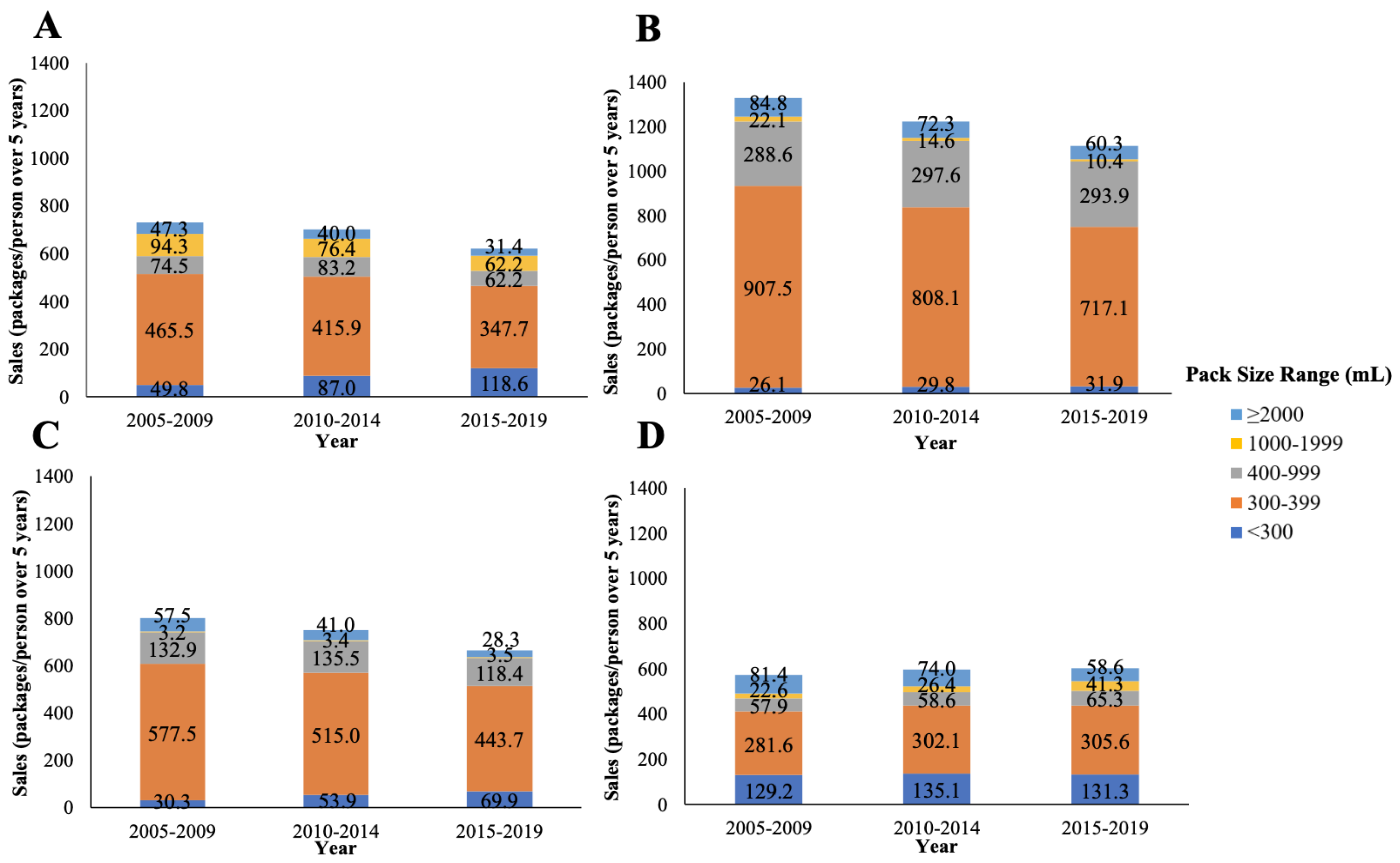
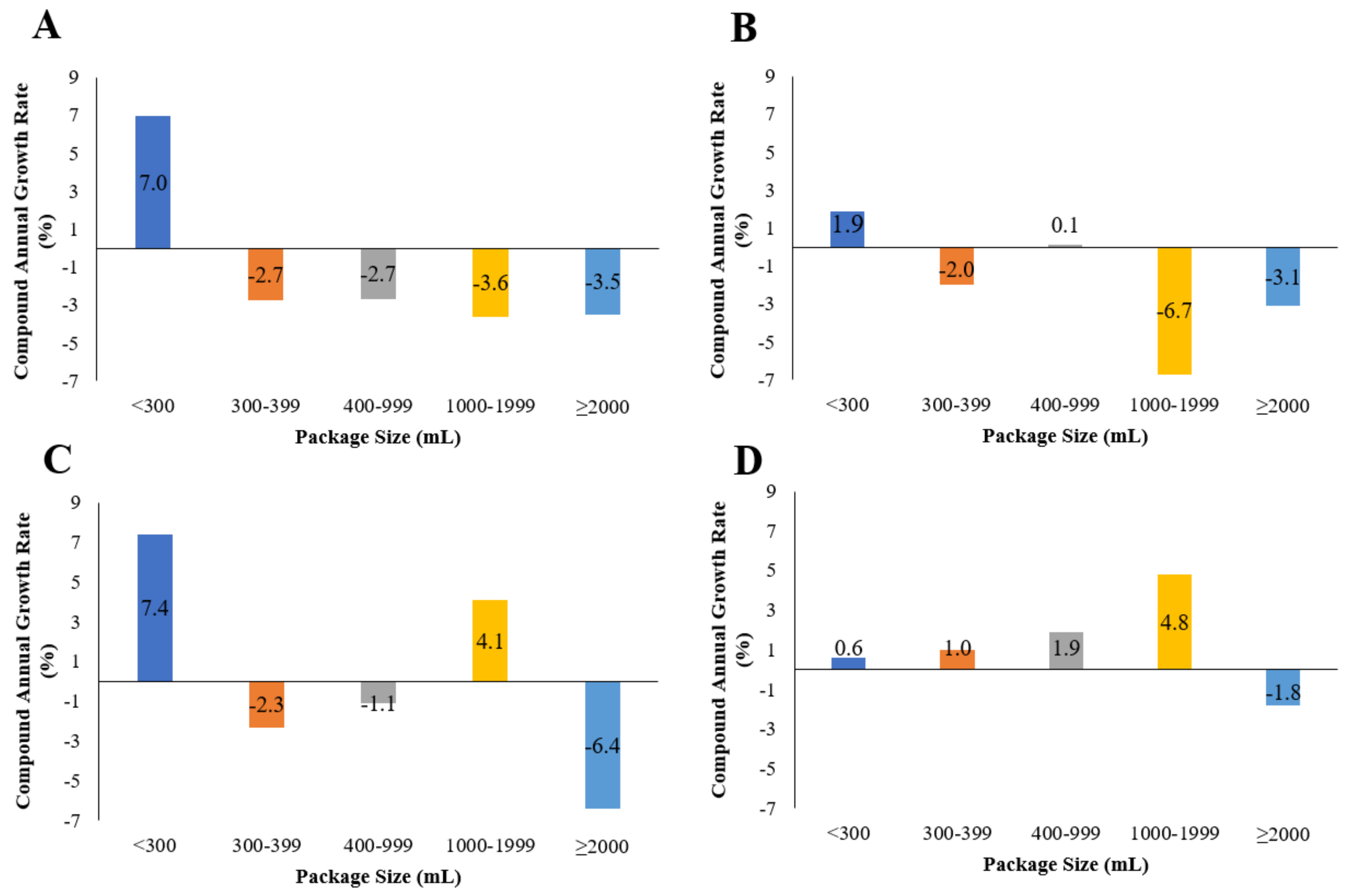
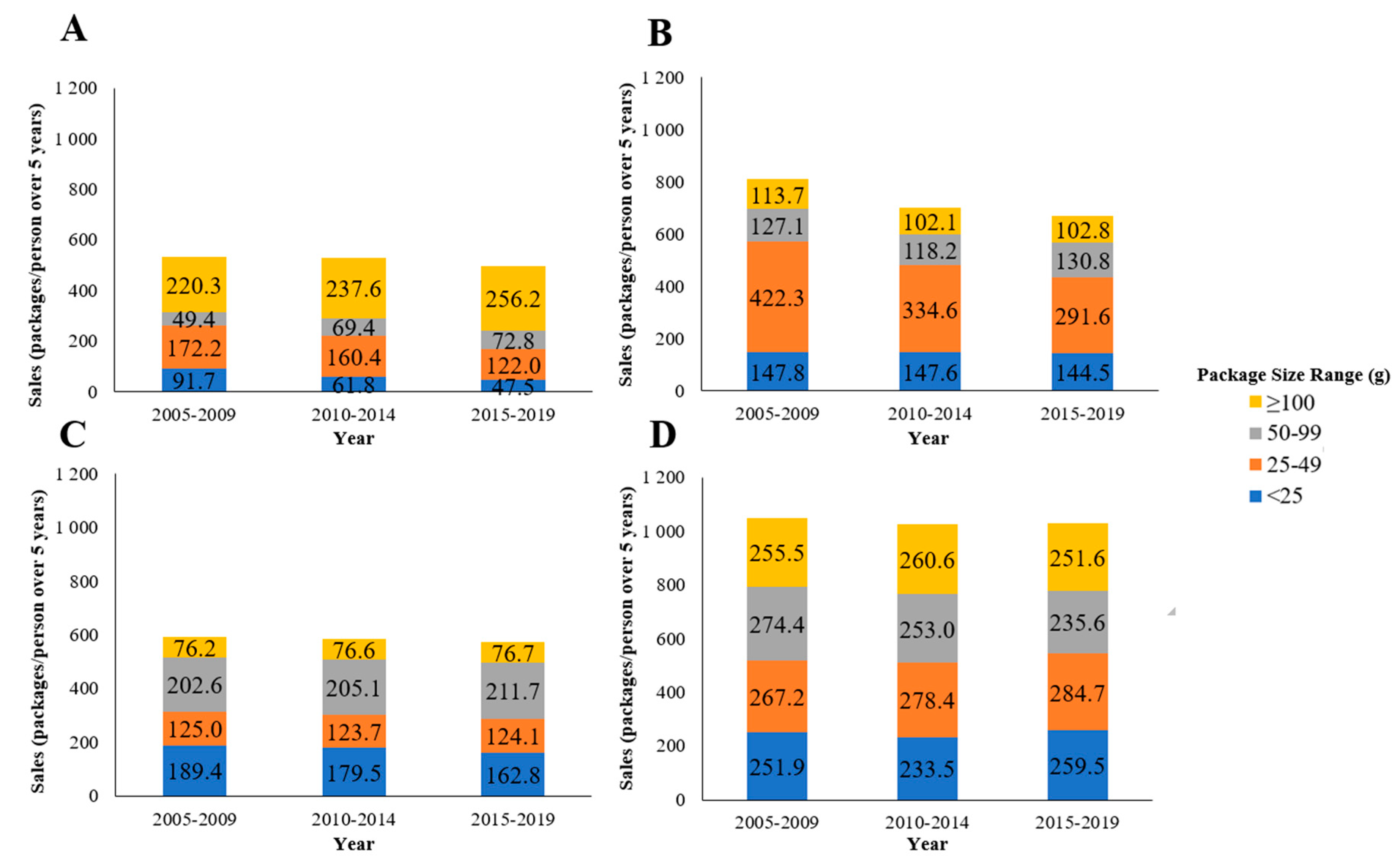
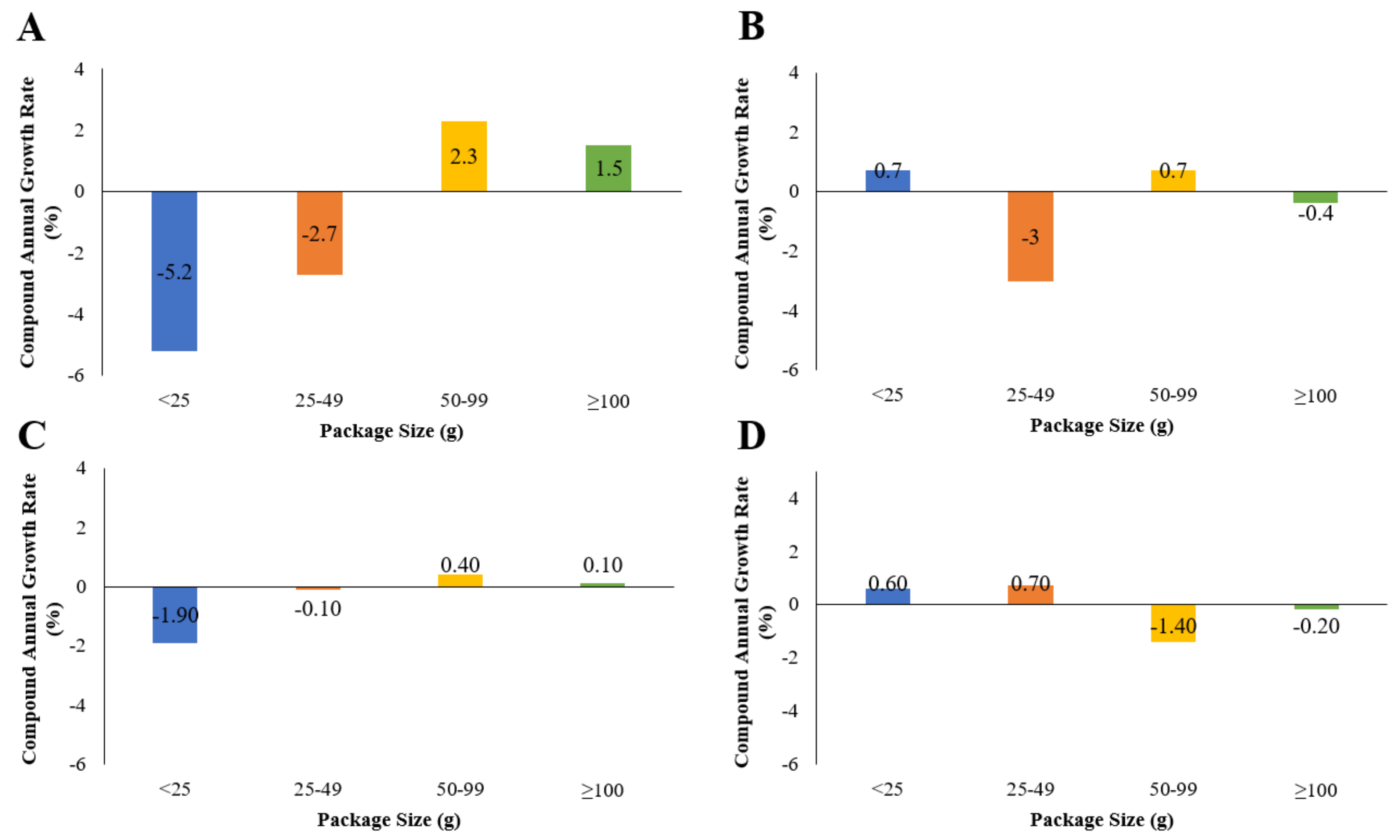
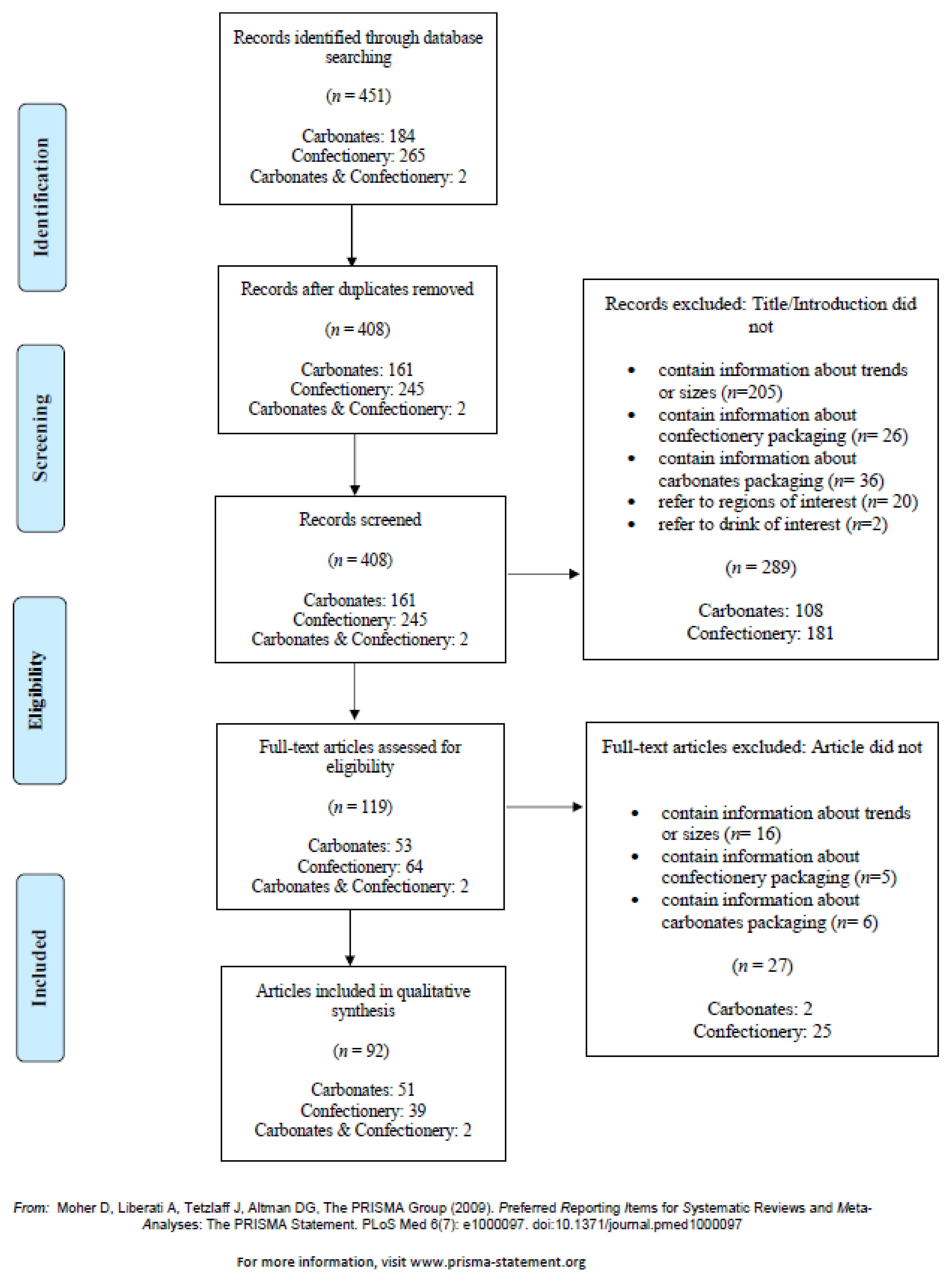
| Increase in Package Size | Decrease in Package Size | |
|---|---|---|
| Country 1 | ||
| Australia | 4 | 12 |
| USA | 3 | 27 |
| UK | 2 | 19 |
| Canada | 2 | 17 |
| Year | ||
| 2005–2009 | 2 | 4 |
| 2010–2014 | 2 | 14 |
| 2015–2020 | 3 | 3 |
| Reason | ||
| Health consciousness | 0 | 30 |
| Convenience | 0 | 17 |
| Portion control | 0 | 14 |
| Market growth | 1 | 13 |
| Innovation | 0 | 12 |
| Expanding product line | 2 | 11 |
| Value for money | 4 | 9 |
| Profit | 0 | 8 |
| Small indulgence | 0 | 7 |
| Sugar tax | 0 | 6 |
| Premiumisation | 0 | 4 |
| Impulse buying | 0 | 3 |
| Manufacturing costs | 0 | 3 |
| Age group | 1 | 3 |
| Sharing trends | 0 | 1 |
| Increase in Package Size | Decrease in Package Size | |
|---|---|---|
| Country 1 | ||
| Australia | 2 | 9 |
| USA | 8 | 11 |
| UK | 11 | 26 |
| Canada | 6 | 10 |
| Year | ||
| 2005–2009 | 0 | 6 |
| 2010–2014 | 8 | 5 |
| 2015–2020 | 8 | 24 |
| Reason | ||
| Sharing trends | 14 | 8 |
| Portion control | 2 | 18 |
| Health consciousness | 0 | 16 |
| Small indulgence | 1 | 14 |
| Value for money/affordability | 7 | 8 |
| Manufacturing costs | 0 | 10 |
| Convenience | 4 | 5 |
| Expanding product line | 2 | 6 |
| Profit | 2 | 4 |
| Innovation | 2 | 3 |
| Premiumisation | 0 | 2 |
| Impulse buying | 0 | 1 |
Publisher’s Note: MDPI stays neutral with regard to jurisdictional claims in published maps and institutional affiliations. |
© 2021 by the authors. Licensee MDPI, Basel, Switzerland. This article is an open access article distributed under the terms and conditions of the Creative Commons Attribution (CC BY) license (https://creativecommons.org/licenses/by/4.0/).
Share and Cite
Jensen, C.; Fang, K.; Grech, A.; Rangan, A. Trends in Sales and Industry Perspectives of Package Sizes of Carbonates and Confectionery Products. Foods 2021, 10, 1071. https://doi.org/10.3390/foods10051071
Jensen C, Fang K, Grech A, Rangan A. Trends in Sales and Industry Perspectives of Package Sizes of Carbonates and Confectionery Products. Foods. 2021; 10(5):1071. https://doi.org/10.3390/foods10051071
Chicago/Turabian StyleJensen, Chloe, Kirsten Fang, Amanda Grech, and Anna Rangan. 2021. "Trends in Sales and Industry Perspectives of Package Sizes of Carbonates and Confectionery Products" Foods 10, no. 5: 1071. https://doi.org/10.3390/foods10051071







